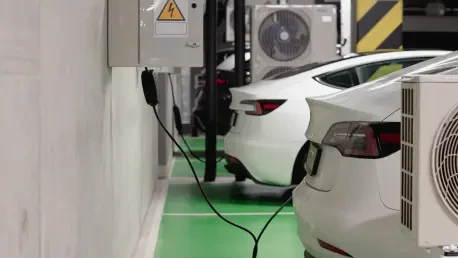Imagine a world where electric vehicles can travel 1,000 miles on a single charge, eliminating range anxiety and transforming the way people think about sustainable transportation with groundbreaking technology. This vision is closer to reality thanks to a pioneering advancement by 24M Technologies, a US-based company pushing the boundaries of battery design. Their innovative Electrode-to-Pack (ETOP) system, a “cell-less” approach to battery construction, promises to redefine performance standards for electric vehicles (EVs), electric vertical takeoff and landing (eVTOL) aircraft, and energy storage solutions. By achieving up to 50% more range without increasing battery pack size, this technology addresses some of the most pressing challenges in the EV industry. As global demand for efficient and cost-effective batteries surges, such breakthroughs are vital for maintaining competitiveness and meeting environmental goals. This development marks a significant step forward, offering a glimpse into the future of electric mobility with unprecedented potential.
Breaking New Ground in Battery Design
Revolutionizing Structure with ETOP Technology
The cornerstone of 24M Technologies’ breakthrough lies in the ETOP system, which fundamentally reimagines how batteries are built. Traditional designs encase electrodes in individual cells and modules, resulting in a substantial portion of the pack being occupied by non-energy-storing materials—often 40-70% of the total volume. The ETOP approach, however, stacks sealed anode and cathode pairs directly into the battery pack, boosting the proportion of energy-storing materials to as much as 80%. This shift not only enhances energy density but also slashes manufacturing complexity by integrating assembly into a single machine. With such a streamlined process, production can begin with lower capital investment, making it a practical solution for scaling up. The result is a battery pack that offers superior range—potentially hitting the 1,000-mile mark—while maintaining a compact footprint, a critical factor for EV design and consumer adoption.
Enhancing Efficiency and Reducing Costs
Beyond structural innovation, the ETOP system tackles economic barriers that have long hindered battery advancements. By minimizing inactive components, the design reduces both weight and volume, directly translating to improved efficiency. This approach also simplifies the production line, cutting down on the number of steps and resources needed to assemble battery packs. For manufacturers, this means a more cost-effective process that can be scaled without the prohibitive expenses tied to conventional methods. Additionally, the ability to achieve higher energy density without expanding pack size addresses a key pain point for EV makers striving to balance performance with affordability. As the industry faces pressure to lower costs for consumers, solutions like ETOP could play a pivotal role in making electric vehicles more accessible. This efficiency-focused strategy aligns with broader goals of sustainability, ensuring that performance gains do not come at the expense of economic viability.
Addressing Industry Challenges and Global Competition
Strengthening Domestic Innovation in the US
In an era where global competition in battery technology is fiercer than ever, particularly from Asian manufacturers, 24M Technologies’ development offers a much-needed boost for American innovation. The urgency to close the gap with overseas competitors has been a driving force behind advancements like the ETOP system. Naoki Ota, President and CEO of 24M, has highlighted the importance of domestic progress to meet the rising demand for high-performance, cost-effective batteries. By focusing on a unique “cell-less” design, the company not only promises enhanced range but also positions itself to reduce reliance on imported solutions. The integration of proprietary technologies, such as the Impervio separator for improved safety and the Eternalyte electrolyte for performance in extreme conditions, further strengthens this competitive edge. Such innovations are crucial for establishing a robust manufacturing base in the US, capable of meeting both consumer and industrial needs.
Aligning with Worldwide Battery Research Trends
The significance of 24M’s breakthrough becomes even clearer when viewed within the context of global efforts to advance EV battery technology. Across the world, research institutions and companies are exploring diverse approaches to increase energy density, reduce charging times, and enhance safety. For instance, developments in lithium-sulfur batteries aim for ultra-fast charging, while novel electrode designs target ranges exceeding 745 miles. These parallel efforts share a common objective with 24M’s work: to push the boundaries of what batteries can achieve. The ETOP system stands out for its focus on structural efficiency, but it complements the broader trend of prioritizing sustainability and performance. As the industry evolves, this convergence of goals underscores the collective drive to support the growing adoption of electric vehicles. By aligning with these global priorities, 24M’s technology contributes to a unified push toward a cleaner, more efficient future in transportation.
Looking Back at a Transformative Leap
Reflecting on a Milestone in EV Progress
Looking back, the unveiling of 24M Technologies’ ETOP system marked a turning point in the journey toward high-range electric vehicle batteries. This “cell-less” design tackled inefficiencies head-on by maximizing active materials and streamlining production, setting a new benchmark with the potential for a 1,000-mile range. The integration of safety and performance features ensured that the technology addressed multiple challenges simultaneously. Its impact resonated beyond technical specifications, offering a glimpse of how innovation could reshape the competitive landscape for American manufacturers. By reducing reliance on foreign solutions, this advancement laid the groundwork for a stronger domestic industry, capable of meeting modern demands with confidence.
Charting the Path Forward for Battery Innovation
As the dust settled on this remarkable achievement, attention shifted to the next steps for scaling and refining such technologies. The success of the ETOP system highlighted the need for continued investment in research to further optimize energy density and manufacturing efficiency. Collaboration between industry stakeholders and policymakers became essential to support widespread adoption and integration into mainstream EV production. Moreover, exploring how this design could adapt to emerging applications, like eVTOL aircraft, opened new avenues for growth. The legacy of this breakthrough served as a reminder that persistent innovation, paired with strategic implementation, could drive the electric mobility sector toward unprecedented heights, ensuring sustainable solutions for generations to come.









